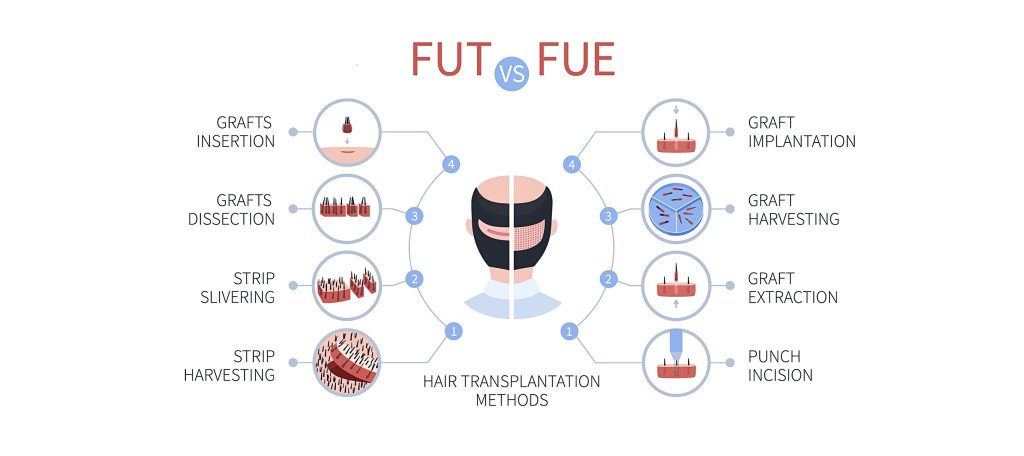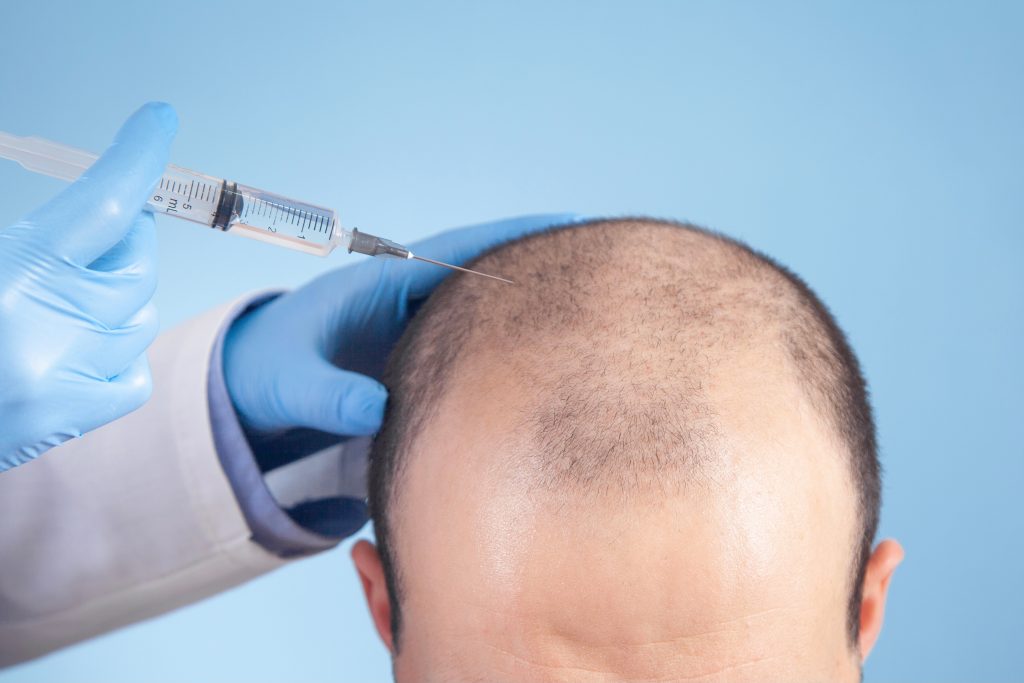Low-Level Laser Therapy (LLLT), a form of phototherapy, is a non-surgical treatment option for stabilisation of hair loss. Clinical studies demonstrate that low-level laser therapy halts the progression of hair loss, stimulates hair growth, resulting in thicker, stronger hair shafts and promotes re-growth in many. It is a treatment option for patients who are not candidates for surgery, or for men and women with thinning hair or hair loss.
There is good scientific evidence that LLLT is effective in improving the thickness and fullness of hair, as a combination therapy (finasteride, minoxidil, hair transplant) to achieve good results as part of a hair loss treatment program as dual or triple therapy acts synergistically.
When applied to the scalp, Low-Level Laser Therapy has been found to:
- Increase cell metabolism and the health of blood vessels in the scalp for thicker and more resilient hair
- Halt progression of hair loss and in some cases, encourage re-growth
- Promote vascularity in the scalp, distributing nutrients to the roots
- Stimulate sebaceous glands for healthier-looking hair

Best Candidates for Laser Therapy
The most suitable people for laser therapy are men and women in the early to moderate stages of hair loss. Treatment will not be as effective for those who are in the advanced stages of hair loss.
How Hair Grows: The Phases of the Hair Growth Cycle

The hair growth cycle consists of three phases: Growth (Anagen), Resting (Telogen) and Transition (Catagen). At any given time, 10-20% of the hair is in the Catagen or Telogen phase waiting to be shed and replaced by an active Anagen hair (similar to the way a baby tooth is pushed out by a permanent tooth). Laser therapy energizes and stimulates hair follicles in the Catagen (transition) and Telogen (resting) phases causing a new Anagen hair to be formed.
Oral Medication
Finasteride (also known as Propecia®) is an oral medication to be taken once a day. Finasteride works by blocking the conversion of testosterone to dihydrotestosterone (DHT). By lowering DHT levels in the scalp, it reduces DHT’s harmful effect on hair follicles. Finasteride decreases DHT concentrations in the serum and the scalp by up to 70 and 60%, respectively. Daily use for three months or more may be necessary before a patient will notice the prevention of further hair loss or increased hair growth.
Topical Medication
Minoxidil (also known as Rogaine®) is a topical medication (available without a prescription) that is applied to the scalp twice daily. It is available in a 2%- or 5%-strength liquid or a 5%-strength foam. In clinical trials, minoxidil has been shown to reduce hair loss, stimulate hair growth, and strengthen existing strands of hair. Increased hair growth is seen after approximately 4 months of treatment.
HAIR TRANSPLANT

Hair transplant is an effective, permanent treatment for hair loss and balding that occurs with age in both men and women. Hair transplantation is a surgical technique that moves hair from a part of the scalp with plenty of hair, most commonly the back or sides of the scalp, called the”donor site”, to a bald or balding part, most commonly the front or top of the head known as the “recipient site”.
Pros and cons of hair transplants at a glance
Hair transplants can be an effective treatment for hair loss, but not every balding person is a candidate for hair restoration. A successful hair transplant depends on the appropriate selection of patients. Missed diagnosis can lead to poor surgical outcomes. Hair transplants are not suitable for:
- Women with a widespread pattern of hair loss throughout the entire scalp
- People who do not have enough “donor hair sites” from which to obtain hair from
- People who have a tendency to form bad scars such as keloids
- People whose hair loss is due to medication such as chemotherapy, or an autoimmune condition
Consider the pros and cons before you decide whether to have a hair transplant.
Pros
- Hair transplants are usually permanent
- They can give you back your natural-looking hair
- Boosts self-esteem
- Improves appearance
Cons
- Can be costly
- Not covered by health insurance
How Hair Transplants Work
Two types of hair transplantation techniques predominate, including the follicular unit transplantation (FUT) and follicular unit extraction (FUE) techniques. The most suitable treatment will depend on the individual’s needs and the recommendations of the hair transplant practitioner.

Follicular Unit Extraction (FUE)
This procedure first involves shaving the back of the head. While the patient is under local anesthesia, individual hair follicles are harvested from the back of the head, and tiny incisions are placed in the scalp. The individual follicles that were removed from the back of the head are inserted into these incisions, and the surgical site is covered with gauze or bandages.
Follicular Unit Transplantation (FUT)
In this procedure, a strip of the skin is removed from the back of the head. The affected area is then closed with stitches. Next, the doctor will separate the strip of skin and divide it into thousands of grafts, which will contain between one and four hair follicles. Using a needle and scalpel, the doctor will then make tiny incisions in the scalp where the grafts are to be transplanted. Grafts are inserted into these incisions and the surgical site is covered with bandages or gauze.
Dr Donald Ng’s Approach
Dr Donald Ng only uses the manual Follicular Unit Extraction (FUE) technique for hair transplantation as it can offer patients significant benefits over the traditional “strip method” techniques used in Follicular Unit Transplantation (FUT) procedures.
This manual method causes less trauma to the skin and is also a technique that requires skill, and artistry. Due to the manual dexterity required, many hair restoration physicians use robotic-assisted technologies.
Dr Donald Ng is one of the few hair transplant practioners who performs this critical step himself. He firmly believes that graft harvesting should be approached as artistically as the transplanting process. This is because the punching techniques used to harvest the hair play an essential role in the overall aesthetic result. Punch size is directly related to the potential scarring produced from this surgery; with a smaller punch size, the potential for noticeable scarring is dramatically reduced and results are extremely natural-looking
The level of discomfort reported with FUE hair transplant surgery is also significantly less than with FUT procedures and because it is less invasive, there is minimal downtime.
How the Alaxis Medical hair transplant experience works

Consultation
Get in the know. A thorough 30-45 minute in-clinic consultation will give you all the facts you need to make an informed decision, including pricing.
If you’re deemed eligible and want to proceed, you can rest assured you’re in the best hands. Congratulations, this can be life-changing.

Your Big Day
Onto the exciting part! A hair transplant procedure will be done over one day.
There is no cutting involved with the delicate instruments we use, but the area is numbed with a local anaesthetic to minimise any discomfort.
You get to listen to your favourite music during the extraction phase, take a short lunch break and rest during the implantation phase.

Post-Procedure Care
Now, the waiting game.
Your transplanted grafts will start growing in about 4-6 months after the procedure, but full results can take up to 12 months.
Our team is with you the entire time, checking in regularly and ensuring you’re happy.
Your hair transplant journey with Alaxis Medical is a full, end-to-end experience. It includes everything from the initial consultation to pre-operative care, your big day in the hands of our unparalleled medical team and aftercare to maximise hair growth.
The best place to start is with a personalised and tailored diagnosis. Start today by securing a hair growth consultation.
Frequently Asked Questions
Why choose hair transplantation with Alaxis Medical?
Not every hair loss sufferer is a candidate for hair transplant and Dr Donald Ng only recommends hair transplantation when he feels it is completely in the patient’s best interest.
Dr Donald Ng has performed hair transplantation since 2006 and has attained surgical proficiency and fulfilled the criteria to be awarded the title of diplomate member by the American Board of Hair Restoration Surgery.
Alaxis Medical is made up of a large dedicated team of hair restoration technicians who have been assisting Dr Donald Ng with hair, beard and eyebrow transplant procedures since 2006 and have gained a wealth of knowledge. This ensures that most procedures can be completed in one day and not multiple sessions. To safeguard his strict standards, Dr Donald Ng performs only one hair transplant procedure per day.
How long do hair transplants last?
Hair transplants are a permanent hair loss solution. For a hair transplant to work, the hair used must be genetically healthy and strong. The hair in the donor area must be within a safe zone to ensure when moved, they will continue to regrow as normal. When performed to the highest standard, the hair growth will mimic that of the hair around the back and sides and grow over the individual’s life. Taking care of transplanted hair properly post procedure is also critical to ensure optimal results.
What is the success rate of hair transplants?
Hair transplants are generally successful procedures. Hair transplantation success is best measured in follicle survival rate, as in how many follicles will take in their new location and start growing hair. When assessing success rates, people should consider that final results may take up to 12 months to show.
At Alaxis Medical, we consistently achieve good results for our clients with a follicle survival rate of over 90% (compared to industry rates that fluctuate between 50-90%). So, over 90% of the follicles implanted into the treatment area continue to grow there for life.
Is a hair transplant procedure painful?
A hair transplant is performed under local anaesthesia. Typically, patients do not have any pain during the procedure and after receiving the local anesthesia. They may report little to no discomfort during the procedure. On rare occasions, patients may experience some pinching or mild discomfort during administration of the local anaesthesia.
How much does FUE cost?
Each case is different with the cost based on a number of factors including the number of grafts needed and the desired final results, in terms of coverage, the patient is hoping to achieve.
How many grafts will be needed?
The number of grafts needed in a FUE procedure depends on the size of the area to be covered and the desired density. Thick hair and grafts containing larger numbers of 3’s and 4’s give the illusion of a fuller head of hair. Unfortunately, this is genetically predetermined. We review patient goals and possible options before determining the number of required grafts during the initial consultation.
Do FUE results look natural?
When performed by an experienced and skilled hair restoration physician, the final results should be so natural in appearance that others will not be able to tell that the hair was transplanted.
Will the new hair grow right away?
Shortly after undergoing an FUE hair transplant, the new hair will look more like stubble on the head. The transplanted hairs may grow very gradually for 2 to 3 weeks before they enter the resting (telogen) phase. During this phase the hair shafts of most, or all, of the grafts will fall out. The transplanted hair will grow once again as it enters the anagen phase after 2 to 3 months. Once hairs are in the anagen growth phase, they will grow as they normally would.
When will the final results be visible?
Once the transplanted hairs enter the anagen growth phase at 2 to 3 months, the new hair will start as thin and fine hair. Over the course of the next several months, the hair will become longer and thicker. At the 10 to 12 month period, coarse hair will start to become evident with the final results becoming visible about 12 months after FUE. Please note that every individual heals at a different rate and the results vary per patient.
What is the recovery time after FUE?
Most patients set aside 2 to 7 days after their procedure to recover. While FUE scars usually heal within 2 to 4 days, it may take up to one week for the donor area to have a healed appearance that is free of scabs. Individual results may vary. Please keep in mind that Alaxis Medical sees patients the first 2 days after the procedure and 1 week after the procedure.
IS FUE the right choice?
The choice about undergoing a hair transplant is a personal decision. As FUE is becoming more efficient, more people inquire about FUE for their hair restoration purposes. Issues that play a role in the final decision include how to style the hair, the lifestyle of the patient, the quality of the hair and the goals of the patient. All of these topics will be discussed during the initial consultation with the doctor.
Is there a need for follow-up or revision FUE?
As patients age, they can progress to a higher Norwood class of hair loss with further loss of their native hair. In these cases, patients can return for a second hair transplant to cover the newly balding areas. The previously transplanted hairs are permanent hairs and patients will not lose them. Some patients may need more transplantation to add density and fullness to the previously transplanted area or to make their hairline more solid.
Before and After Photos
In compliance with MOH guidelines in Singapore, we are not allowed to post before-and-after images on our website and social media platforms. However, we are more than willing to share such images for your perusal during your in-clinic consultation with us.


